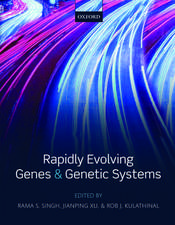Transposable Elements and Genome Evolution: Georgia Genetics Review, cartea 1
Editat de J. F. McDonalden Limba Engleză Hardback – 31 iul 2000
On October 8-10, 1999, 100 molecular biologists and evolutionists representing 11 countries met on the campus of The University of Georgia in Athens for the inaugural Georgia Genetics Symposium. The topics of presentations ranged from how the elements themselves have evolved to the impact transposable elements have had on the evolution of their host genomes. The papers in this volume therefore represent state-of-the-art thinking, by leading world experts in the field, on the evolutionary significance of transposable elements.
| Toate formatele și edițiile | Preț | Express |
|---|---|---|
| Paperback (1) | 950.48 lei 6-8 săpt. | |
| SPRINGER NETHERLANDS – 12 oct 2012 | 950.48 lei 6-8 săpt. | |
| Hardback (1) | 824.11 lei 38-44 zile | |
| SPRINGER NETHERLANDS – 31 iul 2000 | 824.11 lei 38-44 zile |
Preț: 824.11 lei
Preț vechi: 1084.37 lei
-24% Nou
Puncte Express: 1236
Preț estimativ în valută:
157.71€ • 163.65$ • 131.82£
157.71€ • 163.65$ • 131.82£
Carte tipărită la comandă
Livrare economică 14-20 martie
Preluare comenzi: 021 569.72.76
Specificații
ISBN-13: 9780792363064
ISBN-10: 079236306X
Pagini: 299
Ilustrații: VI, 299 p.
Dimensiuni: 210 x 279 x 18 mm
Greutate: 1.09 kg
Ediția:Reprinted from GENETICA, 107:1-3, 2000
Editura: SPRINGER NETHERLANDS
Colecția Springer
Seria Georgia Genetics Review
Locul publicării:Dordrecht, Netherlands
ISBN-10: 079236306X
Pagini: 299
Ilustrații: VI, 299 p.
Dimensiuni: 210 x 279 x 18 mm
Greutate: 1.09 kg
Ediția:Reprinted from GENETICA, 107:1-3, 2000
Editura: SPRINGER NETHERLANDS
Colecția Springer
Seria Georgia Genetics Review
Locul publicării:Dordrecht, Netherlands
Public țintă
ResearchCuprins
I. Introduction.- I. Mechanisms and dynamics of transposable element evolution.- Comparative genomics and evolutionary dynamics of Saccharomyces cerevisiae Ty elements.- Is the evolution of transposable elements modular?.- Molecular paleontology of transposable elements from Arabidopsis thaliana.- Human L1 retrotransposition: insights and peculiarities learned from a cultured cell retrotransposition assay.- Structure, functionality, and evolution of the BARE-1 retrotransposon of barley.- Retrolycl-1, a member of the Tnt1 retrotransposon super-family in the Lycopersicon peruvianum genome.- Retrotransposon 1731 in Drosophila melanogaster changes retrovirus-like expression strategy in host genome.- Regulatory potential of nonautonomous mariner elements and subfamily crosstalk.- Phylogenetic evidence for Ty1-copia-like endogenous retroviruses in plant genomes.- Evidence for genomic regulation of the telomeric activity in Drosophila melanogaster.- How valuable are model organisms for transposable element studies?.- Transposable elements and genome evolution: the case of Drosophila simulans.- Horizontal transfer of non-LTR retrotransposons in vertebrates.- Sure facts, speculations, and open questions about the evolution of transposable element copy number.- Transposon dynamics and the breeding system.- Recently integrated human Alu repeats: finding needles in the haystack.- Phylogenetic signals from point mutations and polymorphic Alu insertions.- II. The impact of transposable elements on host genome evolution.- Transposable elements as the key to a 21st century view of evolution.- Transposable elements as activators of cryptic genes in E. coli.- Drosophila telomeres: two transposable elements with important roles in chromosomes.- Molecular domestication-more than a sporadicepisode in evolution?.- Genomes were forged by massive bombardments with retroelements and retrosequences.- Sectorial mutagenesis by transposable elements.- Cell-surface area codes: mobile-element related gene switches generate precise and heritable cell- surface displays of address molecules that are used for constructing embryos.- Transposable DNA elements and life history traits. II. Transposition of P DNA elements in somatic cells reduces fitness, mating activity, and locomotion of Drosophila melanogaster.- Host defenses to parasitic sequences and the evolution of epigenetic control mechanisms.- Sex brings transposons and genomes into conflict.- Key word Index.- Author Index.
















